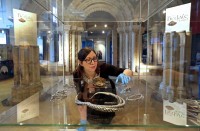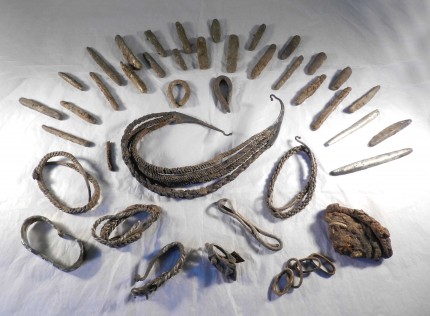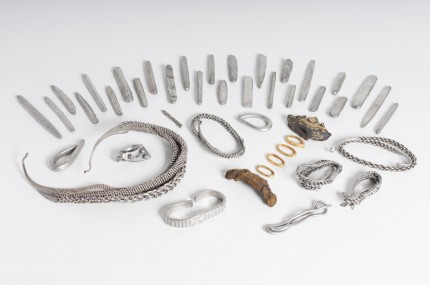 The Bedale Hoard, a trove of Viking silver and Anglo-Saxon gold discovered by metal detectorists in a field near Bedale, North Yorkshire, in May of 2012, is now on display at the Yorkshire Museum after months of conservation. It dates to late 9th or early 10th century and contains almost 40 pieces: 29 silver ingots, four silver collars including a unique large one made of four twisted ropes joined at the ends, silver neck rings, a silver Permian (from the Russian Perm region) ring, a flat silver arm ring made in Viking Ireland decorated with a Hiberno-Scandinavian design, half a bossed pennanular silver brooch, and an Anglo-Saxon iron sword pommel inlaid with gold foil plaques decorated in animal motifs of the Trewhiddle style plus four oval ring mounts and six gold rivets from the same sword.
The Bedale Hoard, a trove of Viking silver and Anglo-Saxon gold discovered by metal detectorists in a field near Bedale, North Yorkshire, in May of 2012, is now on display at the Yorkshire Museum after months of conservation. It dates to late 9th or early 10th century and contains almost 40 pieces: 29 silver ingots, four silver collars including a unique large one made of four twisted ropes joined at the ends, silver neck rings, a silver Permian (from the Russian Perm region) ring, a flat silver arm ring made in Viking Ireland decorated with a Hiberno-Scandinavian design, half a bossed pennanular silver brooch, and an Anglo-Saxon iron sword pommel inlaid with gold foil plaques decorated in animal motifs of the Trewhiddle style plus four oval ring mounts and six gold rivets from the same sword.
The hoard was declared treasure trove at a coroner’s inquest, and British Museum experts valued it at £51,636. In January of this year the Yorkshire Museum launched a fundraiser so they could pay the valuation price and secure the hoard. Several of the pieces are unique anywhere in the Viking world, and little is known about Viking life in the Bedale area so the museum was keen to acquire it for display and study in the county where it was found. The Art Fund and the Victoria and Albert Purchase Grant Fund chipped in £11,000 each. Smaller grants from other organizations and donations from the public raised the rest. In June, the Yorkshire Museum became the proud custodian of the Bedale Hoard.
 A few pieces — the four-strand twisted neck collar, the flat silver arm ring, some of the ingots — were put on display at the museum during the campaign to inspire donations. Since the successful completion of the campaign, the York Archaeological Trust has been cleaning and conserving the hoard, making it ready for permanent display. Conservation has revealed tiny cuts in the silver that were made before the hoard was buried to test the purity of the silver. Several of the newly cleaned ingots were found to have a cross engraved on them, linking them to Christian owners at some point in their early history.
A few pieces — the four-strand twisted neck collar, the flat silver arm ring, some of the ingots — were put on display at the museum during the campaign to inspire donations. Since the successful completion of the campaign, the York Archaeological Trust has been cleaning and conserving the hoard, making it ready for permanent display. Conservation has revealed tiny cuts in the silver that were made before the hoard was buried to test the purity of the silver. Several of the newly cleaned ingots were found to have a cross engraved on them, linking them to Christian owners at some point in their early history.
Natalie McCaul, curator of archaeology at York Museums Trust, said: “It is only now that the hoard has been conserved that we can see its real beauty and the incredible craftsmanship involved in creating some of the artefacts. The Anglo Saxon sword pommel is probably the stand out piece. This is something that has been plundered by the Vikings and the conservation has meant we can now see the fantastic and delicate gold leaf patterns much more clearly and in some cases for the first time,” she said. […]
Conservation work has revealed the gold leaf work, which would have been done by highly skilled craftsmen, on the sword pommel for the first time.
A museum spokesman said: “The Anglo Saxon gold sword pommel, its guard and the gold rings from the handle were all removed from the weapon at some point before burial. Samples taken from the guard reveal both textile and wood fragments, suggesting the sword may have been wrapped in cloth and the hoard was buried in a wooden box.”
As of Saturday, the Bedale Hoard is on display in the Yorkshire Museum’s Medieval Gallery, and boy does it look great. It makes for spectacular before and after pictures.

